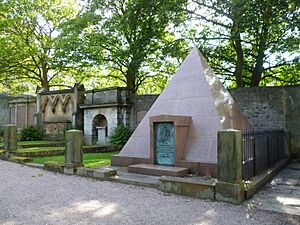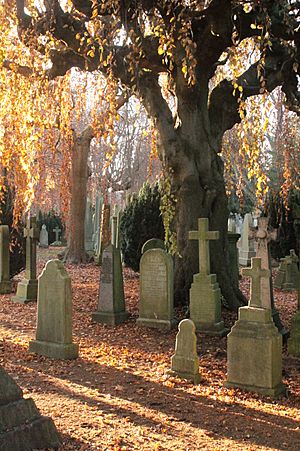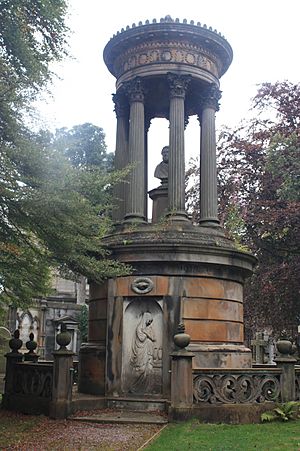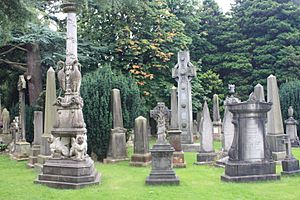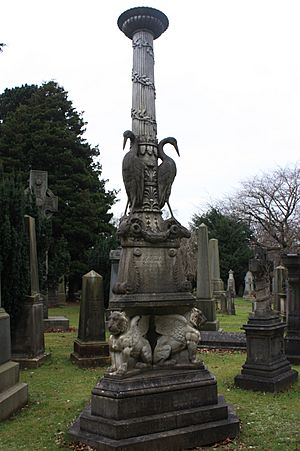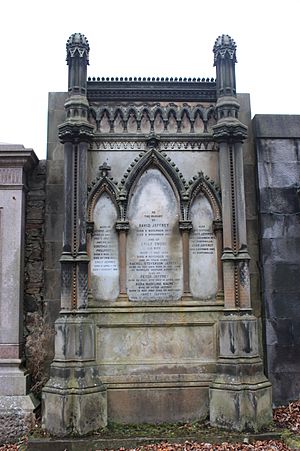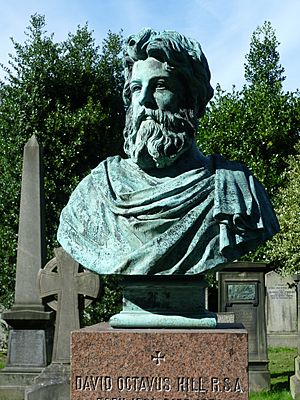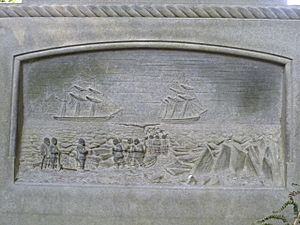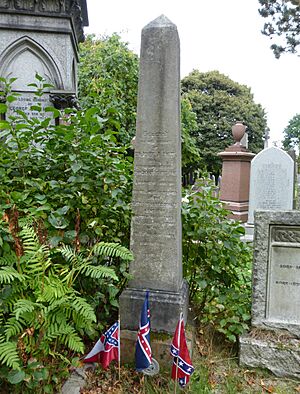Dean Cemetery facts for kids
The Dean Cemetery is a very old and important cemetery in Edinburgh, Scotland. It was built in the Victorian era, a long time ago. You can find it west of Edinburgh city centre, near the Dean Village. It's a peaceful place between Queensferry Road and the Water of Leith river.
Contents
What is Dean Cemetery?
Dean Cemetery was first called Edinburgh Western Cemetery. It was designed in 1846 by an architect named David Cousin. He also designed another famous cemetery in Edinburgh called Warriston Cemetery. This cemetery became a popular burial spot for wealthy and important people. The many monuments here tell stories about Scottish history, showing what people achieved in times of peace and war, both at home and in other countries. It's like a history book carved in stone!
As more and more people wanted to be buried here, the cemetery was made bigger in 1871. New gates were added, and eventually, the new part was connected to the old. Later, in 1877, another section was bought north of Ravelston Terrace. This part wasn't used much until 1909. It's a simpler area, but it does have a row of Scottish judges buried along its north wall. This might remind you of the "Lord's Row" in the older part of the cemetery, where many important people are buried.
The Dean Cemetery is still owned by a private group called the Dean Cemetery Trust Limited. This means it's managed just as it was planned to be, keeping its original look and feel. It's a great example of how a cemetery can be a beautiful, designed landscape.
Dean House: A Historic Spot
The cemetery was built on the land where a house called Dean House once stood. This house was built in 1614. The land, known as Dean Estate, was bought in 1609 by Sir William Nisbet, who later became a very important leader in Edinburgh. The Nisbet family had a special job: they were the King's official poultry suppliers! A famous expert on family histories, Alexander Nisbet, is said to have written one of his important books in Dean House. The house was taken down in 1845. Some of its carved stones were saved and are now part of a wall in the cemetery. This lower wall also has graves behind it.
Famous People Buried Here
Many interesting and important people are buried at Dean Cemetery. Here are just a few:
Original Cemetery Section
- Sir William Allan RSA (1782–1850): A famous artist.
- Thomas Annandale (1838–1907): A medical pioneer and surgeon.
- Prof William Edmondstoune Aytoun (1813–1865): A well-known poet.
- William Hamilton Beattie (1842–1898): An architect who designed famous buildings like Jenner's department store and the Balmoral Hotel in Edinburgh.
- Dr Joseph Bell (1837–1911): A doctor who taught at the University of Edinburgh and was a personal surgeon to Queen Victoria. He is said to have inspired the character of Sherlock Holmes!
- Isabella Bird (1831–1904): A brave traveler, writer, and photographer. She was the first woman to become a Fellow of the Royal Geographical Society.
- John Blackwood (1818–1879): A publisher and editor of a famous magazine.
- Sir Thomas Bouch (1822–1880): A railway engineer who designed the first Tay Rail Bridge.
- William Brodie (1815–1881): A talented sculptor.
- Agnes Henderson Brown (1866–1943): A suffragette who fought for women's right to vote.
- James Buchanan and Jane Buchanan: People known for their generous donations to good causes.
- Francis Cadell (artist) (1883–1937): A Scottish artist known for his bright colors. His sister, actress Jean Cadell (1884–1967), and great-nephew, actor Simon Cadell (1950–1996), are also buried here.
- James Carswell (1832–1897): A civil engineer who designed parts of Queen Street Station, Glasgow and the approaches to the Forth Rail Bridge.
- Robert Chambers (1832–1888): A publisher of dictionaries and encyclopedias.
- Lord Cockburn (1779–1854): A Scottish judge and writer.
- George Combe (1788–1858): A lawyer interested in phrenology, a study of the skull.
- George Somervil Carfrae (1854–1934): A civil engineer.
- Prof Daniel John Cunningham (1850–1909): A famous anatomist, buried with his son, General Sir Alan Cunningham (1887–1983).
- Sir William Fettes Douglas (1822–1891): A well-known artist.
- James Faed (1821–1911): An artist.
- Sir James Falshaw (1810–1889): A former Lord Provost of Edinburgh (like a mayor).
- Richard Findlay (1943–2017): A broadcaster and media boss.
- Prof James David Forbes (1809–1868): An inventor of the seismometer, a device that measures earthquakes.
- William Hope Fowler (1876–1933): An early x-ray pioneer who suffered from his own experiments.
- Thomas Richard Fraser (1841–1920): A pathologist, who studies diseases.
- Henry Snell Gamley (1865–1928): An artist.
- Charles Jenner (1810–1893): The founder of Jenners Department Store on Princes Street.
- John Irving (1822–1848 or 49): A lieutenant on a ship in the Franklin Expedition, which searched for the Northwest Passage. His body was found years later and brought here.
- Elsie Inglis (1864–1917): A brave pioneer female doctor and war hero.
- Robert Gemmell Hutchison (1855–1936): An artist.
- David Octavius Hill (1802–1870): A famous artist and pioneer in photography. His monument was made by his second wife, Amelia Robertson Hill (1820–1904), who is buried with him.
- Major-General Sir Hector MacDonald (d. 1903): Known as "The Fighting Mac," a military hero.
- Robert McVitie (1854–1910): A biscuit maker who created the famous digestive biscuit.
- James Nasmyth (1808–1890): The inventor of the steam hammer.
- Samuel Peploe (1871–1935): A Scottish artist.
- William Henry Playfair (1790–1857): A famous architect who designed many buildings in Edinburgh.
- John Ritchie (1778–1870) and John Ritchie Findlay (1824–1898): Important newspaper owners.
- Robert William Thomson (1822–1873): An engineer and the inventor of the pneumatic tyre (air-filled tire).
- Sir William Turner (anatomist) (1852–1916): A well-known anatomist.
- Edward Arthur Walton (1860–1922): An artist.
- Aeneas Francon Williams (1886–1971): A Church of Scotland Minister, missionary, chaplain, writer, and poet. His wife, Clara Anne Rendall, a missionary, teacher, and artist, is also buried here.
- Prof John Wilson (1785–1854): An author who wrote under the name "Christopher North."
Southern Terrace Section
- Alexander Crum Brown (1838–1922): A chemist.
- Duncan Cameron (1825–1901): The owner of The Oban Times newspaper and the inventor of the "Waverley" nib pen. His daughter, artist Mary Cameron (painter) (1865–1921), is also here.
- Francis Brodie Imlach (1819–1891): A pioneer in dentistry and using anesthesia (pain relief).
- Joseph Noel Paton (1821–1901): A famous artist.
- Dr Alexander Wood (1817–1884): The inventor of the hypodermic syringe (a medical needle).
20th Century Extension
- John George Bartholomew: A famous map-maker (though he is buried in Portugal, there is a memorial here).
- Walter Lorrain Brodie (1884–1918): A soldier who received the Victoria Cross for bravery (memorial only).
- Sir John Ritchie Findlay, 1st Baronet (1866–1930): Another newspaper boss.
- Margaret Neill Fraser (1880–1915): A lady golfer and a heroine of the First World War. She died in Serbia, but there's a memorial to her here.
- Sir George Macdonald (1862–1940): An archaeologist.
- Sir Robert Muir (1864–1959): A pathologist, who studies diseases.
- Ella Pirrie (1857–1929): A friend and colleague of Florence Nightingale. She was the first head nurse of Belfast City Hospital.
- Edward Theodore Salvesen, Lord Salvesen (1857–1942): A judge.
Other Interesting Monuments
- A monument for Colonel Robert A. Smith, who was born in Edinburgh but fought in the American Civil War for the Confederate side. He died in 1862.
- A monument for John Wilson (1800–1849), a Scottish singer. He is buried in Canada, but this monument remembers him.
- The cemetery also has the graves of 39 soldiers from the Commonwealth who died in World War I and World War II. These graves are looked after by the Commonwealth War Graves Commission. Most of these war graves are in the newer section of the cemetery.
- There's a monument for the children who died at the nearby Dean Orphanage.


